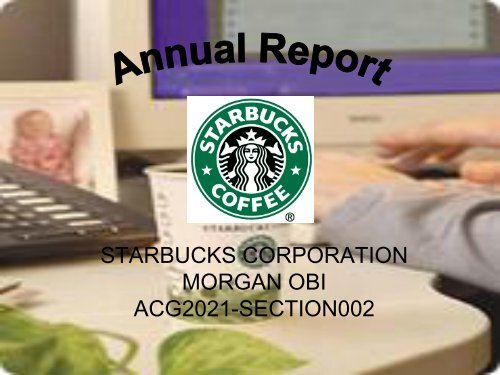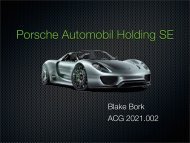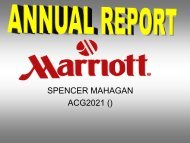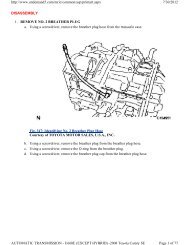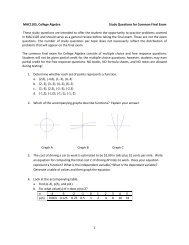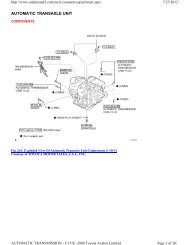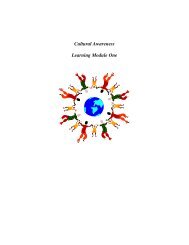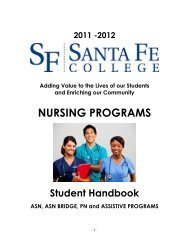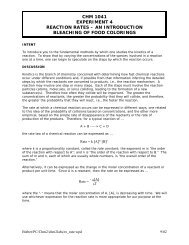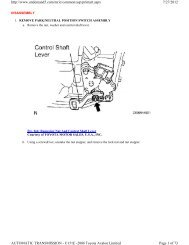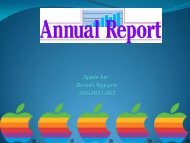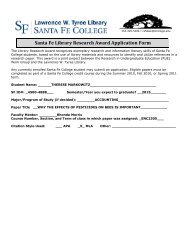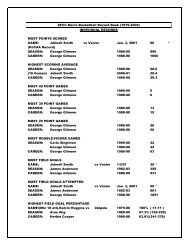mlo-starbucks
mlo-starbucks
mlo-starbucks
Create successful ePaper yourself
Turn your PDF publications into a flip-book with our unique Google optimized e-Paper software.
STARBUCKS CORPORATION<br />
MORGAN OBI<br />
ACG2021-SECTION002
Starbucks Corporation was formed in 1985 and today is the world’s leading<br />
roaster and retailer of specialty coffee. Starbucks purchases and roasts high-quality<br />
whole bean coffees and sells them, along with fresh, rich-brewed coffees, Italian-style<br />
espresso beverages, cold blended beverages, a variety of complementary food items, a<br />
selection of premium teas, and coffee-related accessories and equipment, primarily<br />
through Company-operated retail stores. Starbucks also sells coffee and tea products and<br />
licenses its trademark through other channels such as licensed retail stores and, through<br />
certain of its equity investees and licensees, Starbucks produces and sells a variety of<br />
ready-to-drink beverages. All channels outside the Company-operated retail stores are<br />
collectively known as specialty operations. The Company’s objective is to establish<br />
Starbucks as one of the most recognized and respected brands in the world. To achieve<br />
this goal, the Company plans to continue disciplined expansion of its retail operations, to<br />
grow its specialty operations and to selectively pursue other opportunities by introducing<br />
new products and developing new channels of distribution.<br />
Click here to view Starbucks Corporation's Official Annual Report! (Be sure to click on<br />
11/24/2008)
Starbucks retail stores are typically located in high-traffic, highvisibility<br />
locations. Because the Company can vary the size and format, its<br />
stores are located in or near a variety of settings, including downtown and<br />
suburban retail centers, office buildings and university campuses. All<br />
Starbucks stores offer a choice of regular and decaffeinated coffee<br />
beverages, a broad selection of Italian-style espresso beverages, cold<br />
blended beverages, iced shaken refreshment beverages, a selection of<br />
premium teas and distinctively packaged roasted whole bean coffees.<br />
Starbucks stores also offer a variety of fresh food items, including several<br />
healthy choice selections. Food items include pastries, prepared breakfast<br />
and lunch sandwiches, and salads as well as sodas, juices, and bottled<br />
water.
For the fiscal year ending September 28, 2008<br />
Howard Schultz (pictured left) is the founder of Starbucks<br />
and serves as the Company’s chairman, president, and<br />
chief executive officer.<br />
Location of Home Office:<br />
2401 Utah Avenue South<br />
Seattle, Washington 98134<br />
According to the official Starbucks Annual Report, the United States is the core<br />
geographic market. Their International market (of more than 30 countries)<br />
including Canada, Japan and the UK are also areas of activity.
Starbucks Corporation’s Independent Auditors: Deloitte & Touche LLP<br />
Deloitte & Touche LLP believe that<br />
Starbucks Corporation efficiently<br />
preserved their internal control<br />
over financial reporting during<br />
the fiscal year.
As of February 16, 2009, the most<br />
recent price of Starbucks Corporation<br />
stock is $10.13.<br />
Starbucks has never paid a cash<br />
dividend and presently intends to retain<br />
earnings to help finance the Company's<br />
continued growth.<br />
Due to the current challenging operating and economic environment, I<br />
would sell my stocks in Starbucks. I have read an abundant amount of<br />
information concerning this company and have found that they are not<br />
doing well. They will be closing down over 100 stores and not<br />
repurchasing any of their own stocks.<br />
Click here to view Starbucks Corporation's Twelve Month Trading Range
The Company’s retail goal is to become the leading retailer and brand of<br />
coffee in each of its target markets by selling the finest quality coffee and<br />
related products and by providing each customer a unique experience. After<br />
rigorous evaluation of the US Company-operated store portfolio, Starbucks<br />
created a transformation strategy for expanding its retail business—By<br />
increasing its market share by selectively opening additional stores in<br />
existing markets and opening stores in new markets to support its long term<br />
strategic objectives. In June 2008, the Company committed to close<br />
approximately 600 underperforming Company-operated stores in the US.<br />
The store closures were initiated in the fourth quarter of fiscal 2008 and are<br />
expected to be completed by the end of fiscal 2009.
The format used in Starbucks’ official Annual Report is a<br />
multistep format.<br />
Income Statement Information 2008 2007<br />
(in millions)<br />
Gross Margin 5,737.70 5,412.40<br />
Income from Operating Expenses 503.9 1,053.9<br />
Net Income 315.5 672.6<br />
Since the economy is having troubles, the Gross Margin was<br />
the only increase in 2008 (according to this table). Net Income<br />
and Operating Expenses were larger in 2007.
ASSETS LIABILITIES STOCKHOLDERS' EQUITY<br />
EQUAL PLUS<br />
Fiscal Year (in millions)<br />
2008 5,672.6 = 3,181.7 + 2,490.9<br />
2007 5,343.9 = 3,059.8 + 2,284.1<br />
Assets, liabilities, and stockholders’ equity have all increased<br />
since 2007. At the end of the (2008) fiscal period, the account with the<br />
most change is Assets, with a difference of 328.7 (million). Stockholders’<br />
Equity has an increase of 206.8 (million). Lastly, the account with the<br />
least amount of change was Liabilities, having only a 121.9 (million)<br />
increase.
Cash flows are exceedingly higher than Net Income for the past two years.<br />
As mentioned previously, because of the crisis in the economy, Starbucks is closing<br />
many Company-owned stores.<br />
Therefore, the company experienced a<br />
tremendous loss in Property, Plant and<br />
Equipment during this fiscal year.<br />
Starbucks’ primary source of financing comes<br />
from: proceeds from issuance of commercial papers.<br />
Overall, cash has decreased over the past two years.
Notes to the Financial Statements include the following topics: (1) Summary<br />
of Significant Accounting Policies, (2) Business Acquisitions, (3)<br />
Restructuring changes, (4) Short-term and Long-term Investments, (5)<br />
Derivative Financial Instruments, (6) Inventories, (7) Equities and Cost<br />
Investments, (8) Property, Plant, and Equipment, (9) Other Intangible Assets<br />
and Goodwill, (10) Debt, (11) Other Long-term Liabilities, (12) Leases, (13)<br />
Shareholder’s Equity, (14) Employee Stock and Benefit Plans, (15) Income<br />
taxes, (16) Earnings per share, (17) Commitments and Contingencies, (18)<br />
Segment Reporting, (19) Summarized Quarterly Financial Information.
As of September 28, 2008, the Company’s long-term available-for-sale<br />
securities of $71.4 million included $59.8 million invested in auction rate<br />
securities (“ARS”). As of September 30, 2007, the Company held $75.6<br />
million of ARS, which were all classified as short-term available-for-sale<br />
securities. ARS have long-dated maturities but provide liquidity through a<br />
Dutch auction process that resets the applicable interest rate at predetermined<br />
calendar intervals. Due to the auction failures that began in<br />
mid-February 2008, these securities became illiquid and were classified as<br />
long-term investments. The investment principal associated with the failed<br />
auctions will not be accessible until:<br />
• successful auctions resume;<br />
• an active secondary market for these securities develops;<br />
• the issuers replace these securities with another form of financing; or<br />
• final payments are made according to the contractual maturities of the debt<br />
issues which range from 22 to 37 years.
• The increase in indefinite-lived intangibles was primarily due to the<br />
purchase of distribution rights for Seattle Best Coffee®<br />
• products in Canada as well as the CEC acquisition (see Note 2). The<br />
increase in definite-lived intangibles was primarily due<br />
• to patents acquired in the CEC acquisition. Amortization expense for<br />
definite-lived intangibles was $1.5 million, $1.0 million<br />
• and $1.2 million during fiscal 2008, 2007 and 2006, respectively.
Liquidity Ratios 2008 2007<br />
(in millions)<br />
Working Capital ($441.70) ($459.10)<br />
Current Ratio 0.8 0.79<br />
Receivable Ratio 28.42 29.95<br />
Average days' sales<br />
uncollected 12.84 12.19<br />
Inventory turnover 6.71 5.79<br />
Average days' inventory on<br />
hand 54.4 63.04
Profitability Ratios 2008 2007<br />
(in millions)<br />
Profit Margin 0.07 0.17<br />
Asset Turnover 2.7 2.48<br />
Return on Assets 0.18 0.42<br />
Return on Equity 0.13 0.3
Solvency Ratio 2008 2007<br />
(in millions)<br />
Debt to Equity 1.28 1.34
There is not a dividend yield.<br />
Price/Earnings per share:<br />
2008- 14.9 ($0.43 per share)<br />
2007- 16.39 ($0.87 per share)
As Starbucks moves from fiscal 2008, a year of significant<br />
transition for the company, it is well positioned to deliver in fiscal<br />
2009 with the following foundational planks in place:<br />
• A re-architected cost structure to allow for long-term operating<br />
margin expansion<br />
• A healthier store portfolio achieved through closure of<br />
underperforming stores<br />
• A stronger value and rewards platform - consistent with Starbucks<br />
premium brand<br />
• A renewed emphasis and investment around coffee leadership<br />
• A galvanized company with a common purpose<br />
Click here to see Starbucks Corporation's Investor Webpage (filled with<br />
an abundant amount of question/answers regarding the Company)


